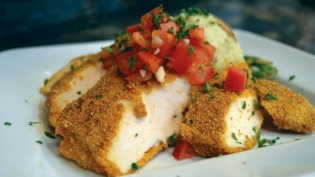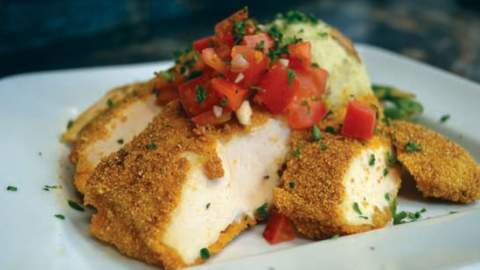Born & Reborn: Restaurants Help to Revitalize Cedar Rapids, Years After the Historic Flood
The guests savoring the poblano pepper, mozzarella balls and spiced chicken on the “Hot Lips” flat bread pizza at Bata’s Restaurant are doing more than dining.
Five years after floodwaters devastated the New Bohemia district and other neighborhoods in the heart of Cedar Rapids, an influx of innovative eating establishments and reopened favorites are drawing crowds to help revitalize the flood-struck city.
“It’s such a commitment for those restaurateurs,” says Marilee Fowler, president and CEO of the Cedar Rapids Area Convention & Visitors Bureau. “They are the key to what we want to offer people.”
Fowler doesn’t need to look far to see the monumental change.
Her office is located in the historic Kosek Building in Czech Village, a southwest Cedar Rapids district inundated by at least 8 feet of water during the epic Cedar River flood.
The river crested June 13, 2008, at 31.12 feet - its highest level in recorded history and 19 feet above flood stage - penetrating 10 square miles of the city.
“It was pretty traumatic,” says Mike Monnahan, owner of The Blue Strawberry in downtown Cedar Rapids. “Everyone figured we’d be down a couple days and back up. But when I saw the water coming at a pretty good clip down the street, it was obvious it was going to be major.”
Monnahan, who had opened the coffee shop and cafe five years earlier, used a flashlight and navigated downtown skywalks to retrieve belongings after the flood.
“We put up a lot of stuff on tables, assuming it would be adequate, but it wasn’t,” he says, citing 4 feet of water that rushed through the building at 118 Second St. SE. “The refrigerators and freezers in the back were all topsy-turvy.”
It took months for the coffee shop to clean out, renovate and resume operations, but Monnahan never questioned the decision.
“I don’t think I considered it a risk,” he says. “We were optimistic about reopening.”
While customers returned and business has stabilized, Monnahan and others point to Blend, a popular downtown restaurant that didn’t fare as well.
“They took the risk and reopened, but maybe the timing wasn’t right,” he says, noting the downtown draws of Theatre Cedar Rapids, the Paramount Theatre and U.S. Cellular Center took years to recover from the flood.
Monnahan cites a synergy with the comeback of those performance venues and downtown restaurants.
The popular, large-scale Downtown Farmers Market, where The Blue Strawberry buys in-season asparagus, greens and tomatoes for some of its dishes, also has been an asset during summer months, he says. “We probably have more restaurants now than before the flood.”
The same is true in New Bohemia and Czech Village, historic districts connected by the Bridge of Lions over the Cedar River. Visitors to the renovated African American Museum of Iowa and relocated and expanded National Czech & Slovak Museum & Library make their way to dining establishments afterward as part of the tourist experience.
Fowler points to four restaurants within yards of the Convention & Visitors Bureau: the new Smuggler’s Wharf, Blue Toad and Village Meat Market & Cafe and the restored Red Frog, along with several bars that serve food and the historic Sykora Bakery, which expanded its menu after the flood.
“It’s so much fun to be in the heart of Czech Village,” she says.
Across the river, father and son duo, Tony and Nick Bata, had considered opening a restaurant far from the city’s core just before flood waters submerged Cedar Rapids.
When flooded businesses needed the site to relocate, the two gave up that location, drawn instead to the re-emerging New Bohemia district.
More than four years after the flood, Bata’s Restaurant opened in the Suchy Building, 1006 Third St. SE, a former jewelry store that withstood 12 feet of flood water, lapping nearly ceiling-high in 2008.
The 1907 building, owned by the Chadima family’s Thorland Co., was gutted and restored to historic standards. Oak floors, exposed brick and an original tin ceiling retain the building’s character and attracted the Batas, who operated a catering business and coffee shop before opening the restaurant.
“We knew this was the right place for us,” says Tony Bata, a physicist by education and chief information officer in Coe College’s information technology department.
His son, Nick Bata, who has worked as a personal trainer and operated Kaffein, a coffee shop in the neighboring Cherry Building, says the two saw New Bohemia’s potential within months of the flood.
The performing arts venue, CSPS Hall, operated by the not-for-profit Legion Arts, reopened after a $6 million renovation. The Chrome Horse Saloon, Parlor City Pub & Eatery, Little Bohemia, Brewed Cafe and NewBo City Market are among venues along Third Street SE that offer diverse dining options in the arts and entertainment district.
Bata’s Restaurant sources as much food locally as possible, including products from the NewBo City Market. More than 50 wines, a variety of Iowa beers and selections such as Angel Pork Rib Wings, Natural Cut Feta Chips and the popular Blueberry Burger have cultivated a loyal following in Cedar Rapids and beyond.
“It’s a destination,” says Karen Erger of rural Ely, who recently met with friend Deb Neyens for lunch at Bata’s. “This brings people in to have dinner and see that the neighborhood’s not all flooded out anymore.”
Neyens, of Swisher, notes that Cedar Rapids was in a growth mode before the flood.
“Downtown was pretty cool and there was a lot going on,” she says. “(Post-flood) everyone was afraid - can we keep this momentum going - but we have.”
Buoyed by the success of local dining establishments that have risen from the flood, the once water-ravaged city has gradually recovered, with other businesses opening alongside restaurants in New Bohemia, Czech Village and downtown, as well as the Time Check neighborhood in northwest Cedar Rapids. Hungry customers have played a vital role in that resurrection.
“Food is an outlet for people to come together, regardless of the occasion or circumstance,” Nick Bata says. “There will always be food to bring people together.”
When You Go...
FYI - A sampling of some of the new and renovated restaurants that opened in flood-affected areas of Cedar Rapids after 2008 includes:
Downtown
Blue Strawberry, 118 2nd St SE
The Lost Cuban 209 3rd Street SE
Cobble Hill, 219 Second St. SE
Zins, 227 Second Ave. SE
White Star Ale House, 305 Second Ave. SE
Flamingo, 1211 Ellis Blvd. NW
Hacienda Las Glorias, 715 First Ave. SW
Czech Village
Smuggler’s Wharf, 87 16th Ave. SW
Red Frog, 88 16th Ave. SW
Blue Toad, 86 16th Ave. SW
New Bohemia
Bata’s,1006 3rd St SE
Parlor City Pub & Eatery, 1125 Third St. SE
Brewed Cafe, 1101 Third St. SE
Little Bohemia, 1317 Third St. SE
Sweetie Pie’s Chicken & Fish, 624 12th Ave SE
FINDING THE PERFECT CZECH RECIPE
CEDAR RAPIDS - Lou Thompson took her share of knocks as she attempted to satisfy the taste buds of customers longing for food from an iconic business that didn’t reopen after the Floods of 2008.
The owner of Village Meat Market & Cafe, 92 16th Ave. SW, Thompson went through more than 200 pounds of meat to create recipes similar to Czech products previously sold at Polehna’s Meat Market in Czech Village.
Polehna’s owner Mike Ferguson cited overwhelming rebuilding costs and a requirement to replace the brick, wood-fired smokehouse with modern smokers in his decision against rebuilding after the flood. The landmark meat market opened in Czech Village in the 1920s and was known as Polehna’s since 1931.
Last year, Village Meat Market & Cafe opened next door to the previous site of Polehna’s, with a 32-seat cafe that serves breakfast and lunch.
Locals sought the jaternice - a Czech sausage - but even more so, Polehna’s signature wieners and a meat that Thompson refers to as Butcher Loaf.
“They were the two that the old Czechs put me through living hell to get it right,” says Thompson, who returned to her hometown after years in the restaurant and casino industry on the Gulf Coast.
“They said, ‘too much salt; not enough pepper,’” she says, smiling as she recalls donating pound after pound of edible trial meats to serve at area missions. “The missions finally said, ‘we’re done.’”
The Butcher Loaf recipe came relatively easily, and after about six months of testing, the wiener recipe was perfected - just about.
“It’s as close as I can get,” Thompson says. “It’s as perfect as I can be without being Polehna’s.”
Customers have responded favorably.
One woman with a thick Bronx accent called in an order after online searches for Czech meats brought her to the Village Meat Market’s website.
Another woman in Indianapolis asked for next-day air on a $120 order of wieners and didn’t balk at the $128 shipping cost.
“She didn’t care,” Thompson says. “She just wanted to taste what she remembered as a child.”







